Special Feature: Products Sally Recommends
Mexico: The Mercados of San Miguel de Allende
This decision was a surprise to many people, including us. Our Mexico experience was slim—as was our Spanish.
I have been a home cook for most of my life. I’ve subscribed to cooking magazines for many years, taken some cooking classes and read MFK Fisher until I’ve almost memorized her books. I had read Diana Kennedy’s Mexican cookbooks, but had not cooked many Mexican dishes. I was familiar with the concept of shopping small specialty stores from my years in Manhattan and farmer’s markets from my years in Oregon, but nothing prepared me for the Mercados and the food markets of Mexico.
El Mercado is essential to Mexican living. Most Mexicans do all their shopping at one (or all) of the three Mercados in San Miguel. The foods available at the Mercados are always fresher than those available in the supermarkets and cost much less.
After a visit to the local supermarket and seeing the dismal offering of produce, I decided to take my colorful Mexican shopping bag—a necessity—in hand and visit the markets. My first visit was to the biggest and busiest market in San Miguel--Tianguis del Martes (Tuesday Market).
Tianguis del Martes (Tuesday Market)
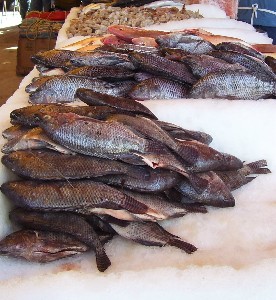 Located about 1 ½ miles from the center of San Miguel, Tuesday market is an open air market that operates every Tuesday from 9:00 a.m. to 4 p.m. This is a huge market that has hundreds of vendors selling everything: fresh produce, fish, chicken, CDs, DVDs, clothes, furniture, kitchenware, radios, cassette, live song birds, used car parts and almost anything else you can imagine. Both gringos and locals frequent this market to get the freshest produce, as well as fish and chicken.
Located about 1 ½ miles from the center of San Miguel, Tuesday market is an open air market that operates every Tuesday from 9:00 a.m. to 4 p.m. This is a huge market that has hundreds of vendors selling everything: fresh produce, fish, chicken, CDs, DVDs, clothes, furniture, kitchenware, radios, cassette, live song birds, used car parts and almost anything else you can imagine. Both gringos and locals frequent this market to get the freshest produce, as well as fish and chicken.
On my first trip there, I bought very little. The sheer size of the market paralyzed me. The fruits and vegetables looked great; in fact, I did buy some onions, potatoes, and radishes. I looked longingly at the open bags of dried beans and dried chiles, but except for the black beans, I couldn’t determine what the beans were. They seemed to have more varieties of pinto beans than I ever knew existed. And I didn’t know how to differentiate a good dried chile from a not so good one. Even if I did, I sure didn’t know what to do with it when I got it home.
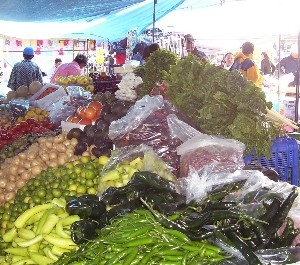 I went home, studied and learned about beans and chiles and talked to more experienced market goers. I found out that dried chiles should be bright in color and pliable, not stiff. And don’t buy any that have large white spots, which may indicate insect infestation. I also found out that the chicken vendor at the market was considered by some to have the best chickens in San Miguel and that the fish monger was widely known to sell the freshest fish in town.
I went home, studied and learned about beans and chiles and talked to more experienced market goers. I found out that dried chiles should be bright in color and pliable, not stiff. And don’t buy any that have large white spots, which may indicate insect infestation. I also found out that the chicken vendor at the market was considered by some to have the best chickens in San Miguel and that the fish monger was widely known to sell the freshest fish in town.
Armed with some knowledge, I left early in the morning the next Tuesday so I could watch the vendors setting up and get the freshest food possible. I made one turn through the market, picking and choosing fruits and vegetables as I went. I was told by a friend to stop by the chicken vendor early so that he could cut up the chicken and have it ready when I was finished shopping. It was good advice. On the way out, I bought some fresh fish for dinner that night. In the central highlands, fresh fish is a real treat.
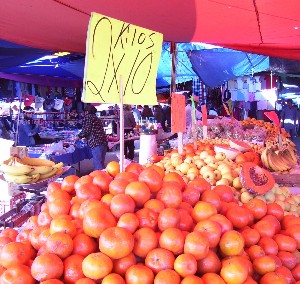 Although I do not speak Spanish and can barely understand how much something costs, I found that the vendors were very patient and extremely polite. I handed them what I thought something cost and they handed me back a mess of change.
Although I do not speak Spanish and can barely understand how much something costs, I found that the vendors were very patient and extremely polite. I handed them what I thought something cost and they handed me back a mess of change.
Walking through the market is quite a bit of exercise and the smells of food cooking always tempt me. That’s when I stop and grab a mid-morning snack of gorditas or tacos from one of the vendors. This was another good tip from a San Miguel friend.
You can get to Tuesday market by bus (4 pesos), by taxi (20 pesos), or by car. There is a large parking lot, where you may park for free.
Mercado Ignacia Ramirez
Now I was pretty much buoyed by my experience at Tuesday market and thought I would venture to where most of San Miguel shops. But I didn’t want to go it alone this time so I signed up for a Market Tour cooking class, taught by Lisa Gahafer. Lisa is a wonderful cook and provides an educational as well as entertaining market tour and cooking class. In 2004 to 2005, the cost was $45.00.
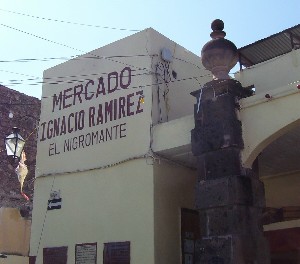 Located just a few blocks from the central town square known as the Jardin in San Miguel, the Mercado Ignacia Ramirez is a permanent, covered market built in 1970. This market is where most locals, including gringos, do their daily shopping for fresh produce, meat, and chicken. On Thursday afternoons, the market is alive with fresh flowers.
Located just a few blocks from the central town square known as the Jardin in San Miguel, the Mercado Ignacia Ramirez is a permanent, covered market built in 1970. This market is where most locals, including gringos, do their daily shopping for fresh produce, meat, and chicken. On Thursday afternoons, the market is alive with fresh flowers.
Lisa walked our small group through the market, stopping at different vendors to show us the amazing variety of fruits and vegetables indigenous to Mexico. For the cooking class that followed the market tour, we picked up nopales (cactus paddles) to use in a salad. Lisa selected an assortment of fresh and dried chiles to use in salsas and a variety of fresh fruits—pineapple, mangoes, papaya--for a spicy fruit salsa. She also selected a tropical fruit, Granada China, which is similar to a persimmon and is great for dessert with an assortment of cheese. Like the persimmon, you cut the Granada China in half and scoop out the seeds to eat.
Across the street from the market is a line of butchers, most of them selling beef and pork. One of them sells carnitas, which is cooked, chopped pork used for tacos. We picked up a kilo (approximately two pounds) of carnitas for our lunch.
At the cooking class, Lisa demonstrated how to make a variety of salsas and ensaaldas and we all got a chance to try our hand at making tortillas, from masa bought at a tortilla factory, on a tortilla press. I’ve included some of Lisa’s recipes at the end of this article.
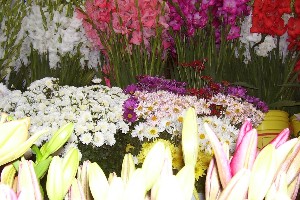 Adjacent to the Mercado Ignacio Ramirez is the San Miguel Artisans, which consists of many vendors selling a myriad of crafts—silver jewelry, pottery for the home, mirrors, and various other crafts. It is definitely worth a visit.
Adjacent to the Mercado Ignacio Ramirez is the San Miguel Artisans, which consists of many vendors selling a myriad of crafts—silver jewelry, pottery for the home, mirrors, and various other crafts. It is definitely worth a visit.
The Mercado Ignacio Ramirez is an easy walk from Centro. Walk east on Mesones until you get to the Plaza Allende (you see the large equestrian statue), then turn left on Colegio. Walk one block and you’ll see the entrance to the Market. The market is open daily from 9:00 a.m. to 9:00 p.m.
Mercado de San Juan de Dios
Now I felt like a professional and was ready to tackle the most Mexican Mercado in San Miguel.
Located about six blocks from the Jardin, the Mercado de San Juan de Dios is the newest of the covered markets, built in 1992. This market is frequented mainly by the Mexican population although the more adventurous gringos have started to attend. This market is open daily from 9:00 a.m. to 8 p.m.
Smaller than the other two Mercados, the Mercado de San Juan de Dios is a covered, permanent market. The market is very attractive--the vendors are separated by red brick interior walls—and very clean. Most of the fruit and vegetable stands didn’t have the variety of the other markets. There did seem to be more meat and poultry vendors at this market, however, and their offerings looked very good.
I wandered through the market and picked up some fruits. I knew about a tortilla factory in the area so I walked over there and picked up fresh tortillas. The price of tortillas, a staple of the Mexican diet, is set by the government. At this writing, a kilo of tortillas cost 7 pesos. I put down 4 pesos and got more tortillas than I thought I could use. We ate four of them as soon as we left the factory—while they were still warm.
Next time, I’m going to buy masa to make my own tortillas. Well, as soon as I get a tortilla press.
![]()
Fruit and Chipotle Salsa
(reprinted with permission from Lisa Gahafer)
2 mangoes, diced
2 cups pineapple, diced
½ cup green onion, minced
3 chile chipotles in adobados, or to taste
½ cup cilantro, chopped
2 tablespoons piloncillo, or dark brown sugar, to taste
juice of 1-2 limes
½ teaspoon salt, or to taste
In a medium-sized bow, combine fruits with the green onion. Remove seeds and veins from chipotles and mince. Add to fruit mixture along with the grated piloncillo and chopped cilantro. Add salt and lime juice. Taste and adjust seasonings.
Ensalada de Nopales
(reprinted with permission from Lisa Gahafer)
4 cups diced nopales (Note: you can also just cut into strips)
2 tablespoons olive oil
salt, to taste
3 tomatoes, diced, or green onions, chopped
1 – 3 serrano chiles, chopped
¼ cup cilantro, chopped
1 – 2 freshly squeezed limes, to taste
- Clean the cactus paddles by trimming the edges and scraping off the spines. Cut into dice or strips.
- Toss the cactus with 1 tablespoon of the oil, sprinkle with salt. Place the cactus on a baking sheet and into a 350 degree oven until it is tender, about 15-20 minutes. Or, you can sauté the cactus in a skillet until tender.
- Mix all the remaining ingredients in a bowl, adding the cactus and the remaining tablespoon of olive oil. Taste and adjust the seasoning.

Arlene Krasner is a former high-tech engineering manager. She is currently living in San Miguel de Allende, Mexico.
Note: This information was accurate when it was published. Please be sure to confirm all rates and details directly with the businesses in question before making your plans.



